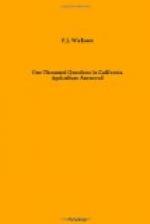There is no best breed. It is a matter of personal preference. Any of the breeds are all right to pen up and feed. The principal thing is to see that the hogs are all pure bred and have not been crossed too often to cause deterioration. Choose one breed of hogs and keep them as pure as possible and you will have no trouble in raising them. All the breeds are good; but some are fancied more than others. Dark-colored hogs are preferred in California because less liable to sunburn.
Part VI. Feeding Farm Animals
Feed for Plow-Horses.
While doing heavy plowing, how many pounds of rolled barley per day should I feed to keep 1300-pound horses in good condition? If I feed part oat hay and part alfalfa hay, together with rolled barley, what ration would be ample?
A ration used by the California Experiment Station was 12 pounds of alfalfa hay, 11 pounds of wheat hay and 7 pounds of crushed barley for 1000 pounds of horse at hard work. The larger the horse the less food for the amount of work he does in proportion to his size, so multiplying these figures by 1.2 would bring a person somewhere near the ration for a 1300-pound horse, and an approximation is as close as one can come to any general ration. Probably more alfalfa and less of the other feeds could well be given, since many farmers are succeeding in feeding alfalfa exclusively.
Vetch for Horses.
Does vetch make good feed for horses? Will vetch produce a heavier crop than grain? When is the best time to sow vetch for hay, and what is the best variety?
Vetch makes excellent stock feed whether used as hay or as pasturage. Vetch falls to the ground so badly that it is very difficult to cut hay from it unless some grain is planted to hold it up. Oats make an excellent hold-up crop and is more generally used. A half a bushel of vetch seed is mixed with a bushel of oats and this is enough to plant an acre. Some growers, however, prefer a bushel of vetch as that makes the stand much heavier.
Sorghum Feeding.
Can I allow milk cows to pasture on growing Kaffir and Egyptian corn during the summer? Which one is the best for pasture and milk?
There is no difference between Kaffir corn and Egyptian corn so far as feeding goes. They are both sorghums. There is a danger in pasturing on young sorghums, because stock is often killed from overeating it, and they are quite apt to do this when they come upon it from dry feed. If you cut and wilt the young sorghum, or if it is fed sparingly with hay, etc., it becomes innocent of injury. After the sorghum has obtained considerable growth, it also loses its dangerous character.
Salting Hay.
What kind of salt is used for salting hay, how much to use and how to apply it?
Any good commercial salt such as is used for pork or beef packing is satisfactory for salting hay. A good handful to the ton, scattering it as the hay is stocked is as good a formula as can be had.




